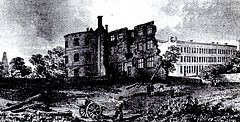Bridgwater Castle
| Bridgwater Castle | |
|---|---|
| Bridgwater, Somerset | |

Remains of the mansion on the site of the castle keep, with houses to the right on Castle Street. Lithograph after a painting in the mid 18th century by John Chubb
|
|
| Coordinates | 51°08′07″N 2°59′56″W / 51.1352°N 2.9990°WCoordinates: 51°08′07″N 2°59′56″W / 51.1352°N 2.9990°W |
| Grid reference | grid reference ST302378 |
| Type | Castle |
| Site history | |
| Built | 1202 |
| Built by | William Brewer |
| In use | 1202-1645 |
| Materials | Old Red Sandstone |
| Demolished | 1645 |
Bridgwater Castle was a castle in the town of Bridgwater, Somerset, England.
The stone castle was built around 1220 and contributed to the development of the town. It was surrounded by a moat and included a watergate giving access to the quay. In the 13th and 14th centuries the castle was involved in the Second Barons' War and Despenser War.
It then fell into ruin and parts were demolished in the first half of the 17th century and a new house built. Some of the walls survived and it played a minor role in the English Civil War and Monmouth Rebellion. In the later 17th and early 18th centuries many of the remaining buildings were demolished and new residential and industrial buildings constructed, giving its name to Castle Street. The watergate and some sections of wall survive.
The castle was built early in the 13th century by William Brewer, like several other castle-builders of the period, an exceptionally wealthy man. He was granted the lordship of the Manor of Bridgwater by King John in 1201, and founded Bridgwater Friary. Before the building of the castle, Bridgwater was much smaller, but after the granting a licence to crenellate by King John, in 1200, charters for the creation of a borough and a market rapidly followed, effectively creating the heart of a new town. Initially Bridgwater faced competition from the established nearby port of Downend, protected by Down End Castle, but the new settlement rapidly became dominant.
Bridgwater Castle was a substantial structure built in Old Red Sandstone from Wembdon with other stone being transported from Downend in the Polden Hills and Ham Hill by boat. The site covered 8 or 9 acres (32,000 to 36,000 m²). A tidal moat, up to 65 feet (20 m) wide in places, flowed about along the current streets of Fore Street and Castle Moat, and between Northgate and Chandos Street. The moat was filled from Durleigh brook, a tributary of the River Parrett. There is some evidence that there was a weir between the moat and the river. Unusually, the main entrance opposite the Cornhill was built with a pair of adjacent gates and drawbridges. In addition to a keep, located at the south-east corner of what is now King Square, documents show that the complex included a dungeon, chapel, stables and a bell tower. Built on the only raised ground in the town, the castle controlled the crossing of the town bridge. There is documentary evidence describing the castle as having "outer and inner bailies and that the buildings included the constable’s house (on the high ground of Kings Square), a chapel (St Marks), hall (Mortemere’s Hall) and chamber, stables, kitchens, horse mill and gatehouse as well as a bell tower and dovecote.
...
Wikipedia

